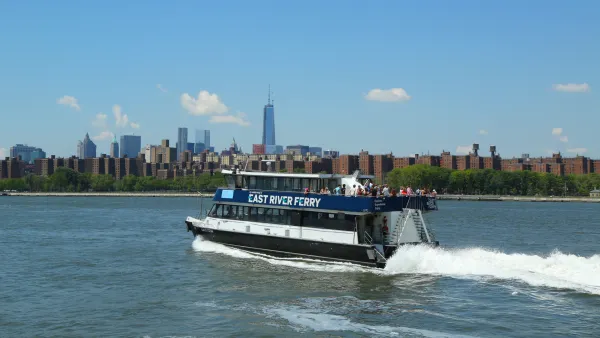Michael Kimmelman resurrects an old plan by Alex Garvin to build a light rail connection between the waterfront neighborhoods of Queens and Brooklyn, except Kimmelman would build a streetcar line.
New York Times Architecture Critic Michael Kimmelman has a plan to bring transit service to one of the well worn paths, or “desire lines” of New Yorkers—one that avoids Manhattan altogether and joins the waterfronts of Queens and Brooklyn. The transit mode of Kimmelman’s choosing: the streetcar.
Kimmelman thinks the two boroughs make sense for a transit connection, but in transit-rich New York, the two boroughs are surprisingly under-serviced: “Right now, it’s easier by subway to get from Long Island City to Midtown, or from Downtown Brooklyn to Wall Street, than it is to get from housing projects in Fort Greene or Long Island City to jobs in Williamsburg, or from much of Red Hook to — well, almost anywhere.”
In responding to the counter argument that bus service could just as adequately provide the capacity Kimmelman would hope to deliver, the critic makes the case for the streetcar’s role in contemporary New York City: “But where’s the romance? A streetcar is a tangible, lasting commitment to urban change. It invites investment and becomes its own attraction. I’m not talking Ye Olde Trolley. This is transit for New Yorkers who can’t wait another half-century for the next subway station.”
As for the potential alignment, Kimmelman cites the details of a plan proposed by Alex Garvin about a decade ago: “The route — others are possible, so let the debate begin — would start in Astoria Park and run along 21st Street. Moving south to Long Island City, it would cross a dedicated, movable bridge to be built across Newtown Creek with bikes lanes and room for pedestrians, restoring a subway bridge torn down years ago.”
Along the lines of the debate requested by Kimmelman in that last quote, Stephen J. Smith provides his dissenting take on the idea: “On a logistical level, the waterfront line falls flat for one fundamental geographical reason: You cannot effectively connect waterfront neighborhoods in Brooklyn and Queens to both each other and the subway.”
FULL STORY: Brooklyn to Queens, but Not by Subway

Analysis: Cybertruck Fatality Rate Far Exceeds That of Ford Pinto
The Tesla Cybertruck was recalled seven times last year.

National Parks Layoffs Will Cause Communities to Lose Billions
Thousands of essential park workers were laid off this week, just before the busy spring break season.

Retro-silient?: America’s First “Eco-burb,” The Woodlands Turns 50
A master-planned community north of Houston offers lessons on green infrastructure and resilient design, but falls short of its founder’s lofty affordability and walkability goals.

Test News Post 1
This is a summary

Analysis: Cybertruck Fatality Rate Far Exceeds That of Ford Pinto
The Tesla Cybertruck was recalled seven times last year.

Test News Headline 46
Test for the image on the front page.
Urban Design for Planners 1: Software Tools
This six-course series explores essential urban design concepts using open source software and equips planners with the tools they need to participate fully in the urban design process.
Planning for Universal Design
Learn the tools for implementing Universal Design in planning regulations.
EMC Planning Group, Inc.
Planetizen
Planetizen
Mpact (formerly Rail~Volution)
Great Falls Development Authority, Inc.
HUDs Office of Policy Development and Research
NYU Wagner Graduate School of Public Service


























